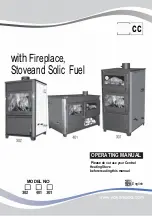
4. Stoking instructions
It is essential to ensure that your chimney draws well. The alpha and omega of stove operation is the interaction
between chimney and stove. Your dealer or chimney sweep will be able to give you advice and guidance about
chimney conditions. If the chimney has not been used for a long time, check it carefully and remove any blockages
before starting to use it.
Once you have made sure of this, the next step is to focus the interaction between your stove and chimney. The
best way to do this is to follow the operating instructions and to use fuel which ignites easily in the combustion
chamber and continues to burn until the chimney draught is sufficient. For additional information about correct
lighting and stoking, visit the Jydepejsen Web site at www.jydepejsen.com.
Please note that the stove paint will harden during the first few lightings. This means that the
stove will generate smoke and emit an odour of paint that will dissipate after about an hour.
It is a good idea to keep the room well ventilated during this phase. Moreover, avoid touching
the stove as this may cause the paint to scale.
As the steel panels will expand and contract during the firing/cooling phases, you may hear a crackling sound. This
is completely normal for sheet metal components, and cannot be considered a defect in the stove.
All Jydepejsen stoves are intermittent.
Initial lighting
1. Turn the air wheel to the maximum
2. Add firelighters and billets to the bottom of the fire box (combustion chamber). Maximum height for billets is 11 cm.
3. The billets (about 1,5 kg) are to be built up crosswise.
4. Light the fire.
5. The door should be ajar for a couple of minutes during the lighting phase.
6. The air wheel must be adjusted down after approx. 10 minutes; how much depends on the
chimney draught - however, the air supply must be diminished to the point where you obtain steady and calm
flames.
Stoking
Once there is a good bed of embers in the stove, you can add wood. It is important not to open the door while
there are flames in the stove, as this may cause smoke to flow out into the room. Add wood on the basis of your
heating requirements. The amount of wood you need to add will depend on the season. However, never add more
than 2 kg of wood every 1.5–2 hours. Please remember that the exterior surfaces of the stove in particular will
become very hot during firing.
1. Turn the air wheel to the maximum.
2. To minimize the underpressure, the door should be ajar for about one minute before you open it completely.
3. Open the door slowly.
4. Add 2 – 3 pieces of firewood to the combustion chamber.
5. Close the door.
6. Turn down the air supply when the fire has caught the wood, to obtain steady and calm flames.
!
GB [4]



























